Related Research Articles
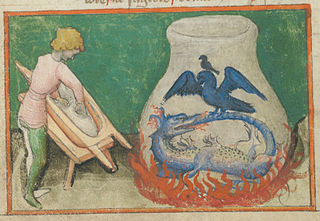
Alchemy is an ancient branch of natural philosophy, a philosophical and protoscientific tradition that was historically practiced in China, India, the Muslim world, and Europe. In its Western form, alchemy is first attested in a number of pseudepigraphical texts written in Greco-Roman Egypt during the first few centuries AD.
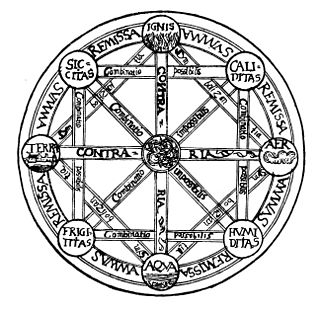
The classical elements typically refer to earth, water, air, fire, and (later) aether which were proposed to explain the nature and complexity of all matter in terms of simpler substances. Ancient cultures in Greece, Tibet, and India had similar lists which sometimes referred, in local languages, to "air" as "wind" and the fifth element as "void".
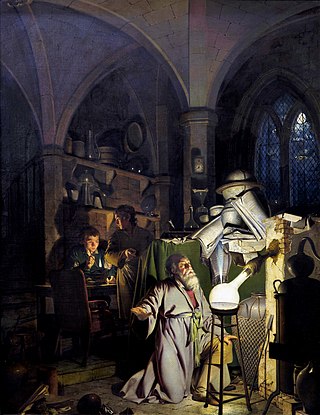
The philosopher's stone is a mythic alchemical substance capable of turning base metals such as mercury into gold or silver. It is also called the elixir of life, useful for rejuvenation and for achieving immortality; for many centuries, it was the most sought-after goal in alchemy. The philosopher's stone was the central symbol of the mystical terminology of alchemy, symbolizing perfection at its finest, divine illumination, and heavenly bliss. Efforts to discover the philosopher's stone were known as the Magnum Opus.

Robert Fludd, also known as Robertus de Fluctibus, was a prominent English Paracelsian physician with both scientific and occult interests. He is remembered as an astrologer, mathematician, cosmologist, Qabalist and Rosicrucian.

Paracelsus, born Theophrastus von Hohenheim, was a Swiss physician, alchemist, lay theologian, and philosopher of the German Renaissance.

The great chain of being is a hierarchical structure of all matter and life, thought by medieval Christianity to have been decreed by God. The chain begins with God and descends through angels, humans, animals and plants to minerals.

An elemental is a mythic supernatural being that is described in occult and alchemical works from around the time of the European Renaissance, and particularly elaborated in the 16th century works of Paracelsus. According to Paracelsus and his subsequent followers, there are four categories of elementals, which are gnomes, undines, sylphs, and salamanders. These correspond to the four Empedoclean elements of antiquity: earth, water, air, and fire, respectively. Terms employed for beings associated with alchemical elements vary by source and gloss.
A homunculus is a representation of a small human being, originally depicted as small statues made out of clay. Popularized in sixteenth-century alchemy and nineteenth-century fiction, it has historically referred to the creation of a miniature, fully formed human. The concept has roots in preformationism as well as earlier folklore and alchemic traditions.
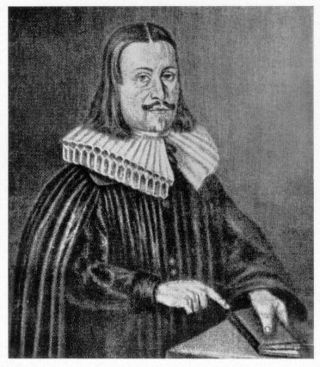
Andreas Libavius or Andrew Libavius was born in Halle, Germany c. 1550 and died in July 1616. Libavius was a renaissance man who spent time as a professor at the University of Jena teaching history and poetry. After which he became a physician at the Gymnasium in Rothenburg and later founded the Gymnasium at Coburg. Libavius was most known for practicing alchemy and writing a book called Alchemia, one of the first chemistry textbooks ever written.

In Renaissance alchemy, alkahest was the theorized "universal solvent". It was supposed to be capable of dissolving any other substance, including gold, without altering or destroying its fundamental components.

The Rose Cross is a symbol largely associated with the legendary Christian Rosenkreuz; Christian Kabbalist, alchemist, and founder of the Rosicrucian Order. The Rose Cross is a cross with a rose at its centre, often red, golden or white and symbolizes the teachings of a Western esoteric tradition with Christian tenets.
A sylph is an air spirit stemming from the 16th-century works of Paracelsus, who describes sylphs as (invisible) beings of the air, his elementals of air. A significant number of subsequent literary and occult works have been inspired by Paracelsus's concept: Robert Alfred Vaughan noted that "the wild but poetical fantasies" of Paracelsus had probably exercised a larger influence over his age and the subsequent one than is generally supposed, particularly on the Rosicrucians, but that through the 18th century they had become reduced to "machinery for the playwright" and "opera figurantes with wings of gauze and spangles".
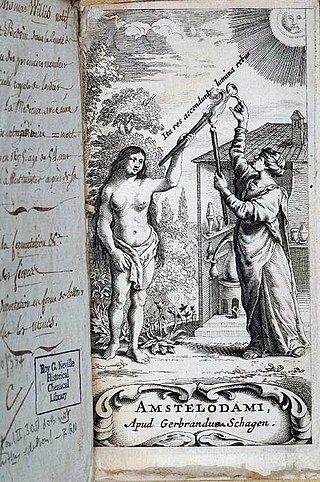
Iatrochemistry is an archaic pre-scientific school of thought that was supplanted by modern chemistry and medicine. Having its roots in alchemy, iatrochemistry sought to provide chemical solutions to diseases and medical ailments.

Gerhard Dorn was a Belgian philosopher, translator, alchemist, physician and bibliophile.

The body of light, sometimes called the 'astral body' or the 'subtle body,' is a "quasi material" aspect of the human body, being neither solely physical nor solely spiritual, posited by a number of philosophers, and elaborated on according to various esoteric, occult, and mystical teachings. Other terms used for this body include body of glory, spirit-body, luciform body, augoeides, astroeides, and celestial body.

Alchemical Studies, volume 13 in The Collected Works of C. G. Jung, consists of five long essays by Carl Jung that trace his developing interest in alchemy from 1929 onward. Serving as an introduction and supplement to his major works on the subject, the book is illustrated with 42 drawings and paintings by Jung's patients.

The Love Potion is a 1903 painting by the English artist Evelyn De Morgan depicting a witch with a black cat familiar at her feet. According to Elise Lawton Smith, the painting "exhibits a Pre-Raphaelite fascination with medieval subjects and decorative detailing." The model was Jane Morris.
The salamander is an amphibian of the order Urodela which, as with many real creatures, often has been ascribed fantastic and sometimes occult qualities by pre-modern authors not possessed by the real organism. The legendary salamander is often depicted as a typical salamander in shape with a lizard-like form, but is usually ascribed an affinity with fire, sometimes specifically elemental fire.

Renaissance magic was a resurgence in Hermeticism and Neo-Platonic varieties of the magical arts which arose along with Renaissance humanism in the 15th and 16th centuries CE. During the Renaissance period, magic and occult practices underwent significant changes that reflected shifts in cultural, intellectual, and religious perspectives. C. S. Lewis, in his work on English literature, highlighted the transformation in how magic was perceived and portrayed. In medieval stories, magic had a fantastical and fairy-like quality, while in the Renaissance, it became more complex and tied to the idea of hidden knowledge that could be explored through books and rituals. This change is evident in the works of authors like Spenser, Marlowe, Chapman, and Shakespeare, who treated magic as a serious and potentially dangerous pursuit.
Occult Science in Medicine is a book by the German doctor and theosophist Franz Hartmann (1838-1912), published in 1893. The aim of the book was to raise awareness amongst doctors and medical students about valuable medical knowledge from the past that has been ignored and catalogued as occult. The treasures of the past, that the author is concerned with and on which he develops his argument, are mostly extracted from the work and perspective of Theophrastus Paracelsus. On a broad level, the book is a comparison between the medical knowledge, practices and system contemporary to the author and those predicated by Theophrastus Paracelsus and supported by Theosophy in general. Additionally, an implicit underlying theme of the book is the nature of science and knowledge - the author advocates against conservative science and contrasts it with progressive science. From a psychological perspective, there is a dualistic representation of the mind and of the body in relation to the constitution of man, diseases and their place in contemporary medicine.
References
- ↑ The Complete Idiot's Guide to Alchemy
- ↑ Fernando, Diana Alchemy: An Illustrated A to Z, Blandford, 1998, pp. 181